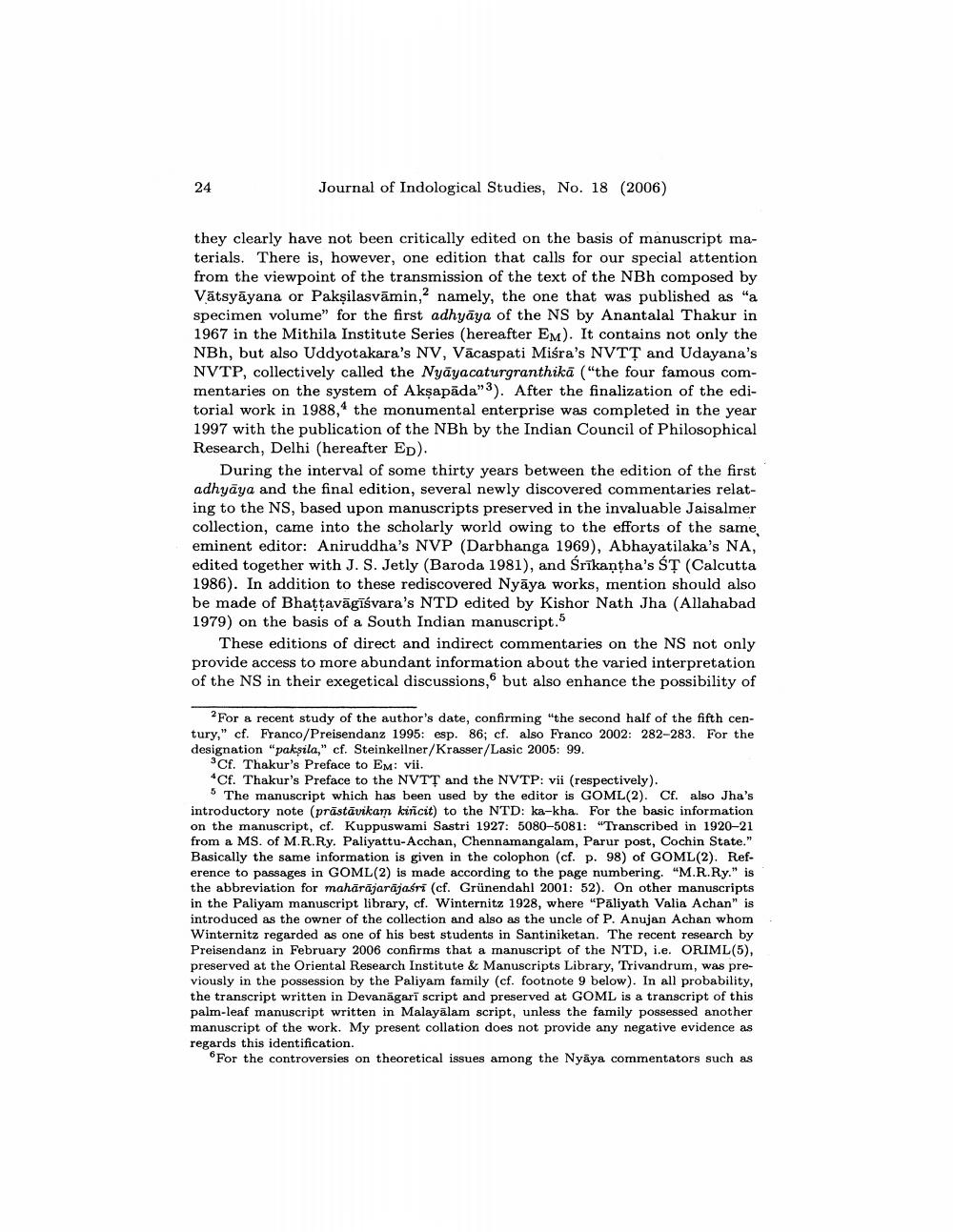Book Title: Some Observations On Manuscript Transmission Of Nyayabhasya Author(s): Yasutaka Muroya Publisher: Yasutaka Muroya View full book textPage 2
________________ 24 Journal of Indological Studies, No. 18 (2006) they clearly have not been critically edited on the basis of manuscript materials. There is, however, one edition that calls for our special attention from the viewpoint of the transmission of the text of the NBh composed by Vātsyāyana or Pakṣilasvamin,2 namely, the one that was published as "a specimen volume" for the first adhyaya of the NS by Anantalal Thakur in 1967 in the Mithila Institute Series (hereafter EM). It contains not only the NBh, but also Uddyotakara's NV, Vacaspati Miśra's NVTT and Udayana's NVTP, collectively called the Nyayacaturgranthikā ("the four famous commentaries on the system of Akṣapāda" 3). After the finalization of the editorial work in 1988, the monumental enterprise was completed in the year 1997 with the publication of the NBh by the Indian Council of Philosophical Research, Delhi (hereafter ED). During the interval of some thirty years between the edition of the first adhyāya and the final edition, several newly discovered commentaries relating to the NS, based upon manuscripts preserved in the invaluable Jaisalmer collection, came into the scholarly world owing to the efforts of the same eminent editor: Aniruddha's NVP (Darbhanga 1969), Abhayatilaka's NA, edited together with J. S. Jetly (Baroda 1981), and Śrīkantha's ST (Calcutta 1986). In addition to these rediscovered Nyaya works, mention should also be made of Bhaṭṭavagīśvara's NTD edited by Kishor Nath Jha (Allahabad 1979) on the basis of a South Indian manuscript.5 These editions of direct and indirect commentaries on the NS not only provide access to more abundant information about the varied interpretation of the NS in their exegetical discussions, but also enhance the possibility of 2 For a recent study of the author's date, confirming "the second half of the fifth century," cf. Franco/Preisendanz 1995: esp. 86; cf. also Franco 2002: 282-283. For the designation "pakṣila," cf. Steinkellner/Krasser/Lasic 2005: 99. 3Cf. Thakur's Preface to EM: vii. *Cf. Thakur's Preface to the NVTT and the NVTP: vii (respectively). 5 The manuscript which has been used by the editor is GOML(2). Cf. also Jha's introductory note (prāstāvikam kiñcit) to the NTD: ka-kha. For the basic information on the manuscript, cf. Kuppuswami Sastri 1927: 5080-5081: "Transcribed in 1920-21 from a MS. of M.R.Ry. Paliyattu-Acchan, Chennamangalam, Parur post, Cochin State." Basically the same information is given in the colophon (cf. p. 98) of GOML(2). Reference to passages in GOML (2) is made according to the page numbering. "M.R.Ry." is the abbreviation for mahārājarajasri (cf. Grünendahl 2001: 52). On other manuscripts in the Paliyam manuscript library, cf. Winternitz 1928, where "Paliyath Valia Achan" is introduced as the owner of the collection and also as the uncle of P. Anujan Achan whom Winternitz regarded as one of his best students in Santiniketan. The recent research by Preisendanz in February 2006 confirms that a manuscript of the NTD, i.e. ORIML(5), preserved at the Oriental Research Institute & Manuscripts Library, Trivandrum, was previously in the possession by the Paliyam family (cf. footnote 9 below). In all probability, the transcript written in Devanagarī script and preserved at GOML is a transcript of this palm-leaf manuscript written in Malayalam script, unless the family possessed another manuscript of the work. My present collation does not provide any negative evidence as regards this identification. For the controversies on theoretical issues among the Nyaya commentators such asPage Navigation
1 2 3 4 5 6 7 8 9 10 11 12 13 14 15 16 17 18 19 20 21 22 ... 42
